Mechanized armor
British tank Mark I
In England
First projects
The answer to the question is how; what means to break through the front, looking for all the warring armies. One of the first who tried to answer him was English Colonel Swinton, who had been in France since the beginning of the war.
October 20 1914, Swinton appealed to the War Department with a proposal to build an armored vehicle on tracks, using the American Holt tractor for this. In his memorandum, Swinton outlined the contours of the new machine and indicated the tasks that she would be able to accomplish in the war.
The Ministry of War was very cautious about these projects. In February, 1915 of the year it organized tests of tracked tractors to test their terrain. The tractors failed to withstand the very harsh technical conditions that were put to the test, and the experiments ceased.
"Big Willy." At the same time, work to create tank led engineer Tritton, together with a representative of the Committee of Land Ships, Lieutenant Wilson. In the fall of 1915, they built a prototype tank. The drawback of it, like all previous samples, was the small width of the overcome ditch. This problem could not be solved using a conventional tractor track. But by the summer of 1915 it was proposed to give the caterpillar a rhomboid shape. This invention of McPhee and Nesfield took advantage of Tritton and Wilson. They also accepted the placement of weapons in the side half-towers (sponsons) proposed by Deincourt, one of the Committee’s employees who created the first prototypes of tanks.
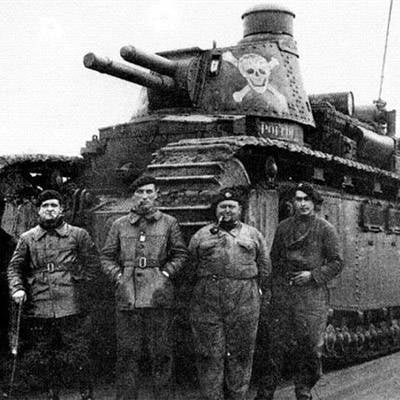
In January, the 1916, a new car, the Big Willy, was named after Lieutenant Wilson. This car became the prototype of the first battle English tank "Mark I".
Thus, the invention of the tank was not the result of the work of one person, but was the fruit of the activities of a number of people, often not even related to each other.
2 February 1916, in Hatfield Park, near London, was tested in the Big Willy. Construction of the first tank was kept a big secret. All who came into contact with the new military invention, were obliged to keep a deep secret. But in the initial period of the construction of the "Big Willie" it was necessary to somehow name the car. She looked like a big cistern or tank. She wanted to be called "water carrier", but it could cause a smile. Swinton, who had become the secretary of the imperial defense committee by that time and closely followed the experimental work, suggested several names: “reservoir”, “tank”, “chan” (in English “tank”).
In France
At about the same time when Swinton appealed to the military ministry with his proposal, Colonel Etienne, the artillery commander of the 6 Division of the French Army, wrote to the commander-in-chief about what he considers expedient to use "armored vehicles for promoting infantry" on the front. A year later, he repeated his proposal: “I consider it possible,” he wrote, “to create tools with mechanical pitch, allowing to transport through all obstacles and under fire at a speed exceeding 6 km per hour, infantry with weapons, ammunition and gun. "
Etienne attached his draft to the letter. He wanted to build a “land battleship” weighing 12 t on tracked chains, armed with machine guns and a cannon. It is characteristic that even the name of the car from the British and the French was the same. "The battleship must have a speed of up to 9 km / h, overcome trenches up to 2 m wide and destroy enemy dugouts .. In addition, the machine will be able to tow on ascents up to 20 ° a seven-toned armored vehicle into which a team of 20 people can be equipped with weapons and ammunition ".
In Étienne, as well as in Swinton, the idea of creating a tracked tank arose from the observation of the work of the Holt tractor.
The first tanks in France began to build the firm Schneider. Soon afterwards, the order was handed over to the Society of Iron and Steel Plants, whose workshops were located in Saint-Chamond. Therefore, the first two French tanks were named Schneider and Saint-Chamon.
In other countries
In other countries - the USA, Germany, Italy, tanks appeared after the British and French vehicles passed tests on the battlefields of the First World War and were recognized by all as a new powerful weapon of modern combat.
Some countries began to build their tanks on the model of the British and French: US tanks were a copy of the British brand V and French Renault tank; Italian tanks were also a copy of the Renault tank.
In other countries, they developed their designs using the experience of tank building in England and France; Germany created the A-7 tank, designed by Volmer’s engineer.
Armored cars
One of the most significant armored vehicles of the First World War period was the Austin. Being built in several variants, Austin was the main armored vehicle of the Russian Army, then it was the most numerous car used by all parties in the civil war in Russia, mainly the Soviets. In contrast to the trench warfare on the Western Front, conditions in the East made it possible to maneuver, and armored cars became much more important than tanks. A number of Austinas have also been used by the British taking part in 1918 battles. Captured Austins were used by several other armies.
Mk. I (Britain) 1916 Propulsion Lieutenant WG Wilson.
The tank had no engine room. The crew and the engine were in the same building. The temperature inside the tank rose to 50 degrees. The crew lost consciousness from exhaust gases and powder smoke. A gas mask or respirator was included in the crew’s standard equipment.
Four people (one of whom was a tank commander) ran a tank. The commander controlled the brake system, two people controlled the movement of the tracks. Because of the strong noise, commands were transmitted by hand signals.
The communication between the tank and the command post was carried out by pigeon mail - for this, there was a special hole for the pigeon in the sponson, or one of the crew members was sent with a report. Later, the semaphore system began to be applied.
The first combat use took place on 15 September 1916. Mark I's 49 tanks were to break through the German defenses under the Somme. Only the 32 tank could start moving. 9 tanks got to the German positions. The tank overcame wire obstacles and trenches 2,7 meter wide. The armor kept hitting bullets and shell fragments, but could not withstand a direct hit by a projectile.
After the first battle under Flers-Courcelette, changes were made to the design of the tank. The new versions are named Mark II and Mark III. Mark III received more powerful armor. Mark III was produced at the start of the 1917 of the year. Used in the first lines of attack in November 1917 in the Battle of Kombrai.
After the appearance of the Mark IV, the Mark I, the Mark II and the Mark III were used as training tanks and for "special" needs. Many were converted into transport tanks. In the battle for Cambrai, Mark I was used as a command tank - equipment for wireless communications was installed in one of the sponsons. Had two modifications Female and Male. Female was armed only with machine guns - instead of guns, two Vickers and four Hotchkiss.
Mark V Tank Britain
Designed and produced in October by Metropolitan Carriage and Waggon Company LTD. Very different from its predecessors. A four-speed, planetary gearbox of the Wilson system and a special tank engine "Ricardo" were installed on it. From now on, only the driver drove the car - there were no onboard gearboxes. A distinctive feature of the МkV was the air intakes of the cooling system, mounted on the sides, the radiator blocked by the motor. The commander's cabin was increased, and another machine gun was placed in the stern. The first MkV began to arrive in the army in May 1917 of the year. Had a commander "tower". He was part of the US Army Tank Battalion 1918. Had a branch for the transport of infantry. But because of poor ventilation, the soldiers were not capable of action. Tank remade for the transport of goods and equipment. After the war, it was used in the sapper version and as a bridge-stacker. He remained in service with the Canadian Army until the beginning of the 310s. An experimental version of the Mark D with the "snake" tracks. Used in armies: France, USA, Estonia, Belarus, USSR, Germany.
400 copies were produced: 200 Male and 200 Female.
To overcome the 3,5 meter Germanic trenches of the Hindenburg Line, an extended version of the Mark V * (Star) - Tadpole Tail was created. 645 instances were built from the 500 Male and 200 Female ordered. Tadpole weight was 33 tons (Male) and 32 tons (Female). On the Tadpole version, a special infantry unit was installed. This was the first use of armored vehicles for the delivery of infantry. The first combat use - 8 August 1918 in the Battle of Amiens.
The Mark V ** (Star-Star) version appeared in May 1918. A more powerful engine was installed on the Mark V **. 197 instances were built from the 750 Male and 150 Female ordered.
SAINT-CHAMOND (France, 1917 year)
Manufacturer - FAMH company from the city of Saint-Chamond. The first Saint-Chamon cars (model 1916) had cylindrical commander and driver's turrets, and the armor plates of the sides reached the ground, covering the undercarriage. The roof was flat. The engine and dynamo were located in the middle of the hull, followed by electric motors. The drive wheel was aft, and there was a second control post there. Armament - 75-mm gun of a special design (400 tanks with this artillery system were produced from 165), which was later replaced by the Schneider 75-mm field gun. Shooting could be done in a narrow sector right on the course, so that the transfer of fire was accompanied by turning the entire tank.
To combat the infantry on the perimeter of the body located 4 machine gun. After the first tests in the middle of 1916, there was a need for some changes. The armor plates of the sides covering the running gear were removed to improve the maneuverability. Caterpillars expanded from 32 to 41, and then to 50, see. In this form, the machine went into production. In 1917, already during the release of Saint-Chamon, they modified it again: the flat roof got tilted to the sides, so that enemy hand grenades would roll off it, instead of cylindrical turrets they would be placed rectangular. The booking was also strengthened - 17-mm armor plates, unlike previous 15-mm, were not penetrated by new German K-type armor-piercing bullets. Then the artillery system was also replaced with a Schneider 75 field gun. FAMH received an order for 400 machines. Release discontinued in March 1918. By the end of the war, the 72 tank remained in service.
A7V "Sturmpanzer" Germany
At first, the Germans borrowed the English name "Tank", then appeared "Papzerwagen", "Panzerkraftwagen" and "Kampfwagen". And 22 September 1918, that is, shortly before the end of the war, the term "Sturmpanzerwagen" was officially approved. The German command considered a lot of prototype tanks, both tracked and wheeled. The base of the tank was the Austrian Holt tractor, produced under an American license in Budapest. Interestingly, Holt was also the base of British and French heavy tanks.
The first extended version, equipped with two Daimler engines with power 100 HP each developed by Josef Vollmer. The first demonstration took place in the spring of 1917. After the tests, some changes were made to the design of the tank. To reduce the weight of 30 mm. armor was left only in the bow (initially 30 mm. Armor was assumed throughout the body), in other parts the thickness of the armor varied from 15 to 20 mm. The thickness and quality of the armor made it possible to resist the armor-piercing rifle bullets (like French7-mm ARCH) at distances from 5 m and more, as well as high-explosive fragmentation shells of light artillery. The commander of the vehicle was located on the upper platform on the left; on the right and slightly behind him - the driver. The top platform was at a height of 1,6 m above the floor. Gunners and machine-gunners were located around the perimeter of the hull. The two mechanics that were part of the crew were located on the seats in front and behind the engines and had to monitor their work. For embarkation and disembarkation of the crew served as hinged doors in the right side - in front and in the left - behind. Under the door outside, two narrow studs were riveted. Inside the hull, two staircases led to the upper platform - front and rear. The gun had a barrel length 26 caliber, rollback length 150 mm, the longest firing range of 6400 m. Ammunition, except 100 shots with high-explosive fragmentation shells, included 40 armor-piercing and 40 crankcase. High-explosive shells had a detonator with a moderator and could be used against field fortifications. The initial speed of the armor-piercing projectile was 487 m / s, armor penetration - 20 mm at a distance of 1000 m and 15 mm on 2000 m. The first build A7V except the hulls differed in the type of gun installation. Standard 7,92-mm MG.08 machine guns differed in the type of installation of the gun. swivel installations with semi-cylindrical masks and screw mechanisms of vertical guidance. The angle of horizontal guidance of the machine gun was ± 45 °.
100 machines were ordered. By October 1917 was made 20 tanks.
The first tank battle between A7V and British female MarkIV took place on March 21 1918. under Sant Etienne. The fight showed the complete superiority of the A7V, equipped with a 57 mm. a cannon on a British tank equipped with machine guns only. The central location of the gun in A7V also proved to be more advantageous than the location of guns in the side sponsons of British tanks. In addition, the tank had the best power / weight ratio.
However, the A7V turned out to be a less successful fighting vehicle. He overcame trenches poorly, had a high center of gravity and ground clearance of the entire 20, see
Renault FT 17 (France 1917 g.)
The first light tank. Produced at the Berliet plants.
A few words about the design of the tank. He had a body of simple shape, assembled on a frame of the corners and shaped parts. The undercarriage consisted of four carriages - one with three and three with two support rollers of small diameter on board, which were assembled on a longitudinal beam. Suspension - blocked, leaf springs. Six supporting rollers united in a cage, the rear end of which was mounted on a hinge. The front end was suspended by a coil spring, which ensured constant track tension. The drive wheel was located at the rear, and the guide, made of wood with a steel rim, in front. In order to increase the maneuverability through the moats and trenches, the tank had a removable “tail” on the axis, turning around which it was thrown onto the roof of the engine compartment.
During the march, a payload or 2 — 3 infantryman could be placed on the tail. The tank was equipped with a Renault carburetor engine. Torque through a conical clutch transmitted to a manual transmission, which had four speeds forward and one back. The crew entered and exited through a tricuspid nasal hatch (there was a spare in the aft part of the tower). The shooter of a cannon or machine gun was located in the tower standing or half-sitting in a canvas loop, which was later replaced with a height-adjustable seat. The tower, which had a mushroom-shaped hinged cap for ventilation, rotated manually. Combat shells (200 fragmentation, 25 armor-piercing and 12 shrapnel) or cartridges (4800 pieces) were located on the bottom and walls of the fighting compartment. In addition to the complex and time-consuming in the manufacture of casting tower, produced riveted, octahedral.
Light tank "Fiat-3000": analogue Renault FT 17
1 - 6,5-mm coaxial machine gun "Fiat" arr. 1929 of the year, 2 - steering wheel, 3 - drive wheel, 4 - jack, 5 - “tail”, 6 - driver's hatch, 7 - double-wing tower hatch, 8 - silencers, 9 - brake pedal, 10 - racks, have a man-down silencer, 11 - a brake pedal, a ramp, 12 - a rammer - engine, 13 - radiator, 14 - gas tank, 37 - 15-mm gun, XNUMX - bulwarks.
Combat weight - 5,5 t, crew - 2 people, engine - "Fiat", 4-cylinder, water cooling, power 50 l. with. at 1700 rpm, speed - 24 km / h, power reserve - 95 km.
Armament: two 6,5 mm machine guns, ammunition - 2000 cartridges.
Armor thickness — 6 — 16 mm
From the very beginning of the release, the FT-17 was produced in four versions: machine-gun, cannon, commander (TSF radio tank) and fire support (Renault BS) with an 75-mm gun in the open top and non-rotating turret. However, the last in battles did not happen to participate - none of the 600 tanks ordered were released until the end of the war.
1025 machines released.
The tank was manufactured under license in the United States under the name Ford Two Man. In Italy under the name FIAT 3000.
In 1919, one copy was captured by the Red Army and sent to Lenin. He gave the appropriate order - and at the Red Sormovo plant the tank was carefully copied and fired with the AMO engine and armor of the Izhora plant under the name "Fighter for freedom comrade Lenin." True, on the way, some parts and assemblies were lost, so, for example, the gearbox had to be redesigned.
The task was accomplished, but only in part: only 15 copies were built, and, according to one of the commissions, they were "unsatisfactory in quality, inconvenient in possession of weapons, and partially completely unarmed."
Austin September 1914
In Birmingham, built a new armored vehicle, specifically for Russian requirements. It was armed with two machine guns in independent turrets, placed next to each other, on both sides of the body. The Russian Army ordered 48 vehicles, and they were produced by the end of 1914. The vehicle used a chassis with an engine on the 30 LS. and controlled rear axle. After the first combat experience, all vehicles were fully restored, changing all armor to new, thicker 7mm armor. The form of the armor remained the same. With a new heavier armor, the engine and chassis were too weak. The car could actually go only on the roads. Despite these shortcomings, the construction of the car was considered a priority. All other armored cars bought by Russians abroad were rated worse, or even useless. It suggests that the construction of Austin should be truly succesfull in order to win the Russian recognition, despite the mistakes.
The Russian government has ordered the next batch of 60 improved vehicles. 1915 have been delivered since August. They used a stronger 1.5t chassis with an AT 50 LS engine, and had thicker armor that did not need further improvement. The hull was cut, and the new roof shape above the driver did not limit the horizontal angle of fire.
On the other hand, the removal of the rear access door of the enclosure was a disadvantage, making access more difficult, through just one door. Also, after the combat experience, it is recognized that armored cars must be equipped with a second driver's post for driving backwards. Therefore, soon after their arrival in Russia, all vehicles were changed. A visible change was the addition of a rear 'application'. The 'application' placed the rear driver post, and also had additional doors. Some cars were equipped with headlights on the roof, in an armored surface.
December 21 1914 in Russia began to form of "automotive platoons MG." Initially, each platoon consisted of three Austin armored vehicles, with support for 4 trucks, a mobile workshop, a tanker truck and 4 motorcycles, one with a sidecar. The platoon command was approximately 50 man. Further platoons formed from the spring 1915, introduced a new organization, with two Austins and one armed with a weapon car (Garford from May 1915 or Lanchester from the spring 1916). Eight existing platoons received an additional Garford three Austins.
Having gained combat experience with the English Austins, the Pulkovo plant in St. Petersburg developed its own, improved type of armored corps, with thicker armor. An essential feature was the turrets, placed diagonally to reduce the width of the car. Automatic rifles could also be raised for anti-aircraft fire.
The first was delivered with a delay in January 1917. During the following months, work went very slowly, due to the chaos in the country. Finally, when production was moved to Izhevsk Plant, the 33 armored vehicles were built 1919-1920.
These cars were called in Russia as "Putilovskiy Ostin", or "Ostin-Putilovets", while the most common name in the Western sources is Putilov. These names were not used in any Russian documents regarding that time, although in 1918-21 they only called: "Russkiy Ostin" (Russian Austin).
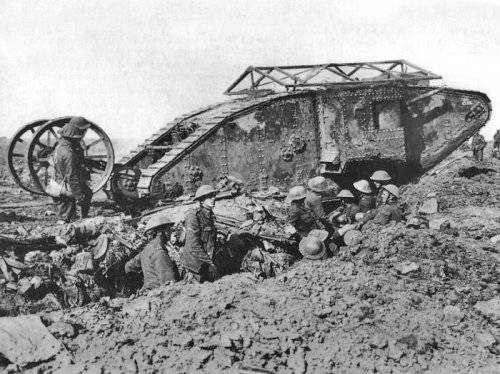
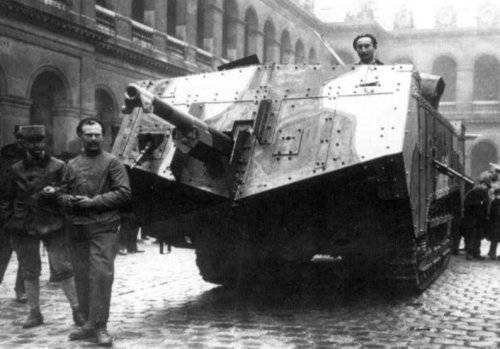
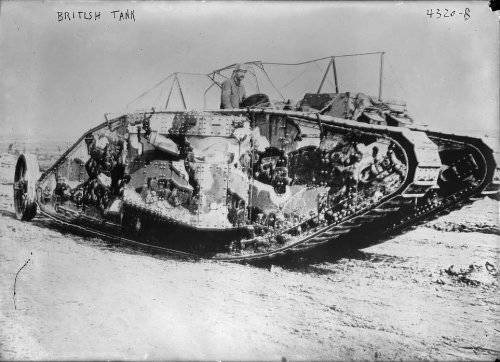
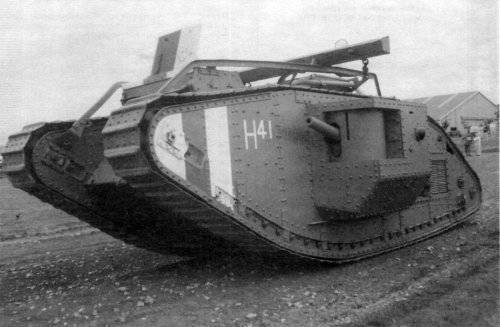

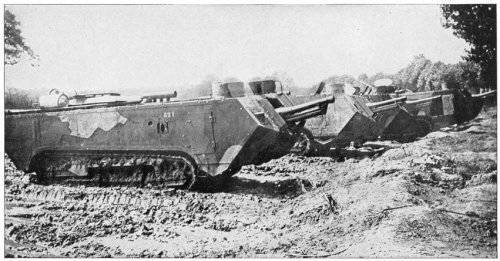
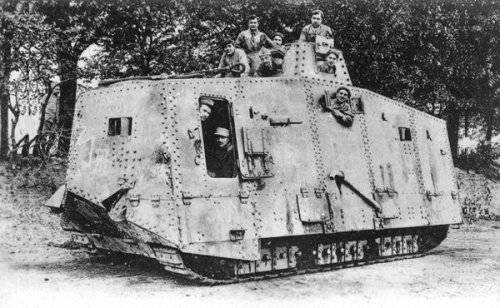
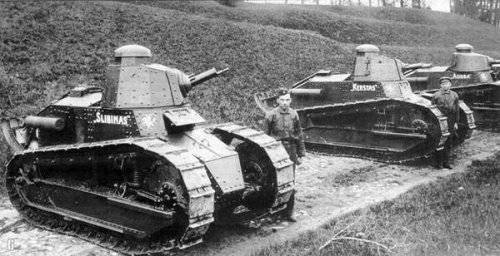
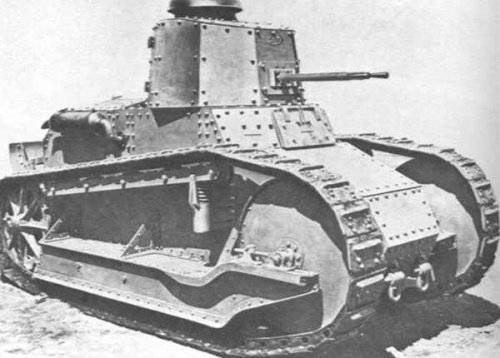
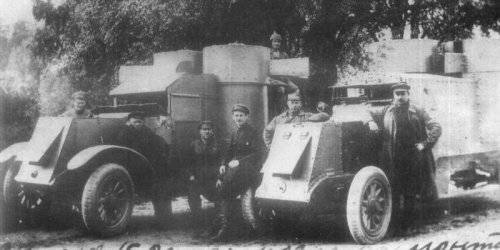
Information